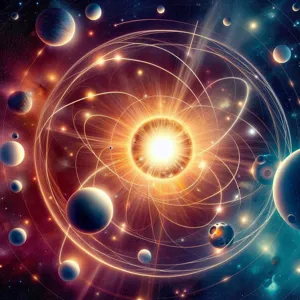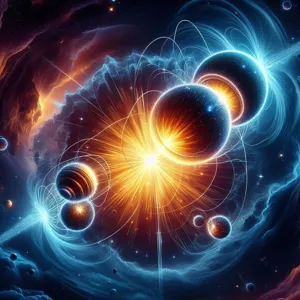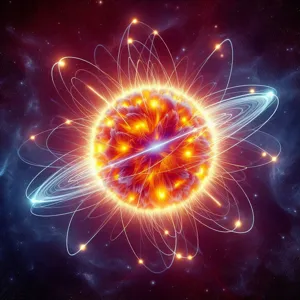As we peer into the depths of the universe, we encounter some of its most enigmatic and captivating phenomena—neutron stars.
Formed from the remnants of supernova explosions, these dense celestial bodies are not just a marvel of astrophysics; they are the key to understanding the fundamental laws of nature. With a mass greater than that of our sun compressed into a sphere no larger than a city, neutron stars defy our comprehension of matter and gravity. In this blog post, we will embark on a cosmic journey to explore the various types of neutron stars, from pulsars that emit rhythmic beams of radiation to magnetars that unleash immense magnetic fields. Join us as we unravel the mysteries of these stellar giants, shedding light on their formation, unique characteristics, and the crucial roles they play in the grand tapestry of the universe. Prepare to be amazed by the wonders of the cosmos!
1. Introduction to Neutron Stars

Neutron stars are among the most extraordinary and enigmatic objects in the universe, capturing the imagination of astronomers and space enthusiasts alike. Formed from the remnants of massive stars that have undergone supernova explosions, these celestial bodies are incredibly dense and compact, packing more mass than our Sun into a sphere no larger than a city. Imagine a star collapsing under its own gravity, forcing protons and electrons to combine into neutrons, resulting in an object so dense that a sugar-cube-sized amount of neutron-star material would weigh around a billion tons on Earth!
Discovered in the 1960s, neutron stars provide a unique laboratory for understanding the fundamental laws of physics under extreme conditions. Their surfaces are incredibly hot, often exceeding a million degrees Celsius, and they possess incredibly strong magnetic fields—trillions of times stronger than that of Earth. As they rotate, many neutron stars emit beams of radiation, creating a lighthouse effect that can be detected as pulsars, spinning at astonishing rates of up to several hundred times per second.
These stellar remnants come in various types, each with its own set of characteristics and mysteries, from ordinary pulsars to the more complex magnetars, which exhibit intense magnetic fields and explosive outbursts. As we delve deeper into the fascinating world of neutron stars, we uncover not only the secrets of their formation and evolution but also the broader implications they hold for our understanding of the universe itself. Join us on this cosmic journey as we explore the captivating types of neutron stars and the wonders they reveal about the fabric of space and time.
2. The Formation of Neutron Stars
The life cycle of a neutron star is a dramatic and violent affair, born from the explosive death of a massive star in a supernova event. When a star that is at least eight times more massive than our Sun exhausts its nuclear fuel, it can no longer support itself against the relentless force of gravity. This leads to a cataclysmic collapse. As the core implodes, temperatures soar to millions of degrees, and nuclear reactions cease. The outer layers of the star are violently expelled into space, creating a spectacular supernova that can briefly outshine entire galaxies.
What remains after this colossal explosion is a dense, compact core made almost entirely of neutrons—these are the building blocks of neutron stars. In this extreme environment, protons and electrons are crushed together under immense gravitational pressure, forming neutrons through a process known as neutronization. The result is an incredible density; just a sugar-cube-sized amount of neutron-star material would weigh as much as a mountain on Earth!
Neutron stars typically measure about 20 kilometers in diameter but can contain more mass than the Sun, making them some of the densest objects in the universe. Their formation is not just a fascinating astronomical event; it also offers profound insights into the fundamental laws of physics under extreme conditions. As we continue to study these enigmatic remnants of stellar life, we unlock the secrets of matter, energy, and the very fabric of the cosmos itself. The formation of neutron stars is not merely a process; it is a cosmic symphony of destruction and rebirth, showcasing the universe’s ability to create something utterly extraordinary from the remnants of the old.
3. Characteristics of Neutron Stars

Neutron stars are among the most extreme and intriguing objects in the universe, born from the cataclysmic collapse of massive stars during supernova explosions. These remnants are incredibly dense, with a mass greater than that of our Sun compressed into a sphere with a radius of approximately 10 to 15 kilometers. This extraordinary density means that a sugar-cube-sized amount of neutron-star material would weigh about as much as all of humanity combined.
one of the most striking characteristics of neutron stars is their composition. As their name suggests, they are primarily made up of neutrons, which are subatomic particles that carry no electrical charge. This results from the gravitational forces so intense that they overcome the electromagnetic forces that normally keep electrons and protons separate. The interior of a neutron star is believed to be a superfluid, a state of matter where particles move without friction, creating conditions unlike anything we experience on Earth.
Neutron stars also possess incredibly strong magnetic fields, often trillions of times stronger than Earth’s. These magnetic fields can accelerate charged particles to tremendous speeds, leading to the emission of beams of radiation from their magnetic poles. When these beams sweep across Earth, they can be detected as pulsars—rapidly rotating neutron stars that emit regular pulses of radiation, much like a cosmic lighthouse.
Another fascinating aspect of neutron stars is their rotation. Many neutron stars spin at astonishing rates, with some completing a rotation in just a few milliseconds. This rapid rotation, combined with the intense magnetic fields, generates powerful jets of particles that can extend far into space, contributing to the cosmic phenomena we observe in the universe.
In summary, neutron stars are not only remarkable for their density and composition but also for their unique magnetic fields and rapid rotation. Their study not only enhances our understanding of stellar evolution but also opens doors to exploring the fundamental laws of physics under extreme conditions. As scientists continue to investigate these enigmatic objects, we inch closer to unraveling the mysteries of the cosmos.
4. Types of Neutron Stars: An Overview
Neutron stars are among the most exotic and intriguing objects in the universe, formed from the remnants of massive stars that have undergone supernova explosions. Their incredible density and unique properties make them a fascinating subject of study for astrophysicists. In this section, we’ll explore the various types of neutron stars, each with its own distinctive characteristics and behaviors.
**1. Pulsars:** Perhaps the most well-known type of neutron star, pulsars are rotating neutron stars that emit beams of electromagnetic radiation out of their magnetic poles. As these beams sweep across space, they create a pulsing effect that can be detected from Earth, much like a lighthouse beacon. Pulsars can be incredibly precise timekeepers, with some spinning hundreds of times per second. Their regularity allows scientists to use them for various applications, including tests of fundamental physics and even as cosmic GPS systems.
**2. Magnetars:** These neutron stars boast incredibly strong magnetic fields, which can be a billion times more powerful than that of a typical neutron star. Magnetars are known for their violent outbursts of high-energy radiation, including X-rays and gamma rays. The immense magnetic forces can lead to phenomena such as starquakes, which release tremendous amounts of energy. Studying magnetars provides insights into the behavior of matter under extreme conditions and the nature of magnetic fields in the cosmos.
**3. Binary Neutron Stars:** In some cases, neutron stars exist in binary systems, orbiting around a companion star. These systems can be particularly exciting to study, especially when two neutron stars orbit each other closely enough to eventually merge. The merger of binary neutron stars has been responsible for spectacular cosmic events, such as the production of heavy elements like gold and platinum through the process of kilonovae. Observing these mergers has opened a new window into understanding gravitational waves and the fundamental forces of the universe.
**4. Hybrid Stars:** A relatively new area of research involves hybrid stars, which may contain a core composed of quark matter in addition to the typical neutron star composition. These enigmatic stars could provide unique insights into the behavior of matter at ultra-high densities and help scientists unravel the mysteries of the strong nuclear force.
In summary, the diverse types of neutron stars not only highlight the complexity of stellar evolution but also challenge our understanding of the fundamental laws of physics. As we delve deeper into the cosmos, each discovery about these fascinating objects expands our knowledge and inspires new questions about the universe’s most enigmatic phenomena.
5. Pulsars: The Lighthouses of the Cosmos

Pulsars, often referred to as the “lighthouses of the cosmos,” are one of the most captivating types of neutron stars found in the universe. Formed from the remnants of supernova explosions, these dense celestial objects are characterized by their rapid rotation and the emission of beams of electromagnetic radiation. As a pulsar spins on its axis, it emits powerful bursts of radio waves, which sweep across space like the beam of a lighthouse.
Imagine standing on a distant shore, watching a lighthouse beam rotate steadily through the dark night sky. As the light passes over you, it illuminates the surrounding landscape for just a fleeting moment before disappearing into the abyss. This is the essence of a pulsar. The intense gravitational forces compress the core of a massive star into an incredibly dense object, resulting in a neutron star that can rotate multiple times per second—some pulsars spin hundreds of times in just a single minute!
The most famous of these stellar beacons is the Crab Pulsar, located at the heart of the Crab Nebula. Discovered in 1968, this pulsar rotates approximately 30 times a second, producing a rhythmic pulse of radiation that can be detected from Earth. Astronomers have found that pulsars can be regular and predictable, making them invaluable tools for testing theories of physics, including general relativity.
Beyond their scientific significance, pulsars also offer a glimpse into the extreme conditions of the universe. Their intense magnetic fields and rapid rotation create environments where matter behaves in ways that challenge our understanding of physics. As researchers continue to study these remarkable objects, they not only unravel the mysteries of neutron stars but also gain insights into the fundamental forces that govern the cosmos.
In summary, pulsars are more than just cosmic phenomena; they are nature’s own beacons, guiding us through the vastness of space while illuminating the intricacies of stellar evolution and the laws of physics. Whether as beacons of stability in a chaotic universe or as subjects of cutting-edge research, pulsars truly embody the wonder and complexity of the universe we live in.
6. Magnetars: The Most Magnetic Objects in the Universe
Magnetars are truly one of the most extraordinary phenomena in the cosmos, standing out not just for their stellar origins but also for their mind-boggling magnetic fields. A type of neutron star, magnetars possess magnetic fields that are a million billion times stronger than that of Earth—an intensity so great it can warp the very fabric of space around them. These fields are believed to arise from the rapid rotation and the unique internal structure of the star after a supernova explosion.
What sets magnetars apart from their neutron star cousins is their propensity to unleash catastrophic bursts of energy. These bursts can be detected as high-energy gamma rays, making magnetars some of the brightest objects in the universe for fleeting moments. The most well-known magnetar, SGR 1806-20, famously produced a gamma-ray burst in 2004 that was the most powerful ever recorded, temporarily outshining the rest of the entire Milky Way galaxy.
The intense magnetic forces present in magnetars also have fascinating implications for their surroundings. When these stars interact with nearby matter or even with the interstellar medium, they can create powerful emissions of X-rays and other radiation. This interaction can lead to stunning displays of cosmic fireworks, observable from Earth with the right instruments.
Astrophysicists continue to study these enigmatic objects, as they hold vital clues about the extreme conditions of the universe. By understanding magnetars, researchers can gain insights into the life cycle of stars, the behavior of matter under unprecedented magnetic pressures, and the intricate workings of the cosmos itself. Truly, magnetars are not just celestial oddities; they are key to unraveling the mysteries of our universe.
7. Hybrid Stars: The Blend of Neutron and Quark Matter

Hybrid stars represent a captivating intersection of two of the most intriguing forms of stellar remnants: neutron stars and quark stars. These celestial bodies emerge from the remnants of massive stars that have undergone supernova explosions, leaving behind cores so dense that the matter within them undergoes dramatic transformations.
At their core, hybrid stars contain a dense region composed primarily of neutrons, a hallmark of neutron stars. However, as pressure increases, the neutrons can break down into their constituent quarks—up, down, and strange quarks—leading to the formation of quark matter. This transition creates a unique state of matter where the traditional boundaries of particle physics start to blur, resulting in a complex composition that challenges our understanding of stellar physics.
One of the most fascinating aspects of hybrid stars is their potential to reveal insights into the behavior of matter under extreme conditions. The study of these stars may provide clues about fundamental questions in astrophysics, such as the nature of strong interactions and the limits of nuclear matter. Observations suggest that hybrid stars might exhibit unusual characteristics, like distinct mass-radius relationships or unique gravitational wave signatures when they collide with other astronomical objects.
As scientists continue to develop advanced observational techniques, hybrid stars become an increasingly important focus of research. Future discoveries could unravel the mysteries of these enigmatic objects, shedding light on the processes that govern the evolution of the universe and the behavior of matter in its most extreme forms. Exploring hybrid stars not only enhances our understanding of the cosmos but also bridges the gap between nuclear physics and astrophysics, illuminating the intricate tapestry of the universe.
8. The Role of Neutron Stars in Supernovae
Neutron stars play a pivotal role in the cosmic ballet of supernovae, acting as both the remnants of stellar explosions and as catalysts for some of the universe’s most spectacular displays. These extraordinary celestial objects are born from the death throes of massive stars, which, having exhausted their nuclear fuel, undergo a catastrophic collapse. When the core implodes, it compresses protons and electrons together, forming neutrons and creating an incredibly dense object that can pack more mass than the Sun into a sphere no larger than a city.
During this process, the outer layers of the star are expelled violently into space, resulting in a supernova explosion that outshines entire galaxies and seeds the cosmos with heavy elements. The energy released in these stellar explosions is not only a sight to behold but also a critical mechanism for the distribution of elements throughout the universe. Elements like carbon, oxygen, and iron—essential components for life as we know it—are forged in the intense heat and pressure of these explosions, scattering into the interstellar medium to eventually coalesce into new stars, planets, and even life.
Furthermore, neutron stars themselves can influence the dynamics of supernovae. In some cases, they can be part of binary systems, where one neutron star pulls material from its companion star. This accretion can lead to thermonuclear explosions, resulting in a Type Ia supernova, which has significant implications for the study of dark energy and the expansion of the universe.
The aftermath of these cosmic events leaves behind a fascinating array of neutron stars, each with unique characteristics, such as pulsars that emit beams of radiation and magnetars with extraordinarily strong magnetic fields. Thus, the interplay between neutron stars and supernovae not only marks the end of one stellar life cycle but also sets the stage for the birth of new celestial bodies, weaving a continuous tapestry of creation and destruction in the universe.
9. Neutron Star Mergers and Gravitational Waves
Neutron star mergers represent one of the most dramatic and energetic phenomena in our universe, and they have recently captivated both astronomers and the general public alike. When two neutron stars collide, the event releases an immense amount of energy, comparable to that of a supernova, but packed into an incredibly brief moment. This cataclysmic event not only gives birth to a new astronomical entity—a kilonova, which is a brilliant explosion that results from the ejection of heavy elements like gold and platinum—but also produces gravitational waves.
Gravitational waves are ripples in spacetime, created by the acceleration of massive objects. The merger of neutron stars generates such powerful gravitational waves that they can be detected billions of light-years away. In 2017, the groundbreaking observation of GW170817 marked a monumental moment in astrophysics, providing the first confirmed detection of gravitational waves from a neutron star merger. This event not only validated Einstein’s theory of general relativity but also opened a new era of multi-messenger astronomy, where astronomers combine observations from different sources—like gravitational waves and electromagnetic signals—to gain a more profound understanding of cosmic events.
These mergers are not just a fascinating spectacle; they also play a crucial role in the universe’s cosmic recycling process. The heavy elements forged in the aftermath of a neutron star collision contribute to the material that forms new stars, planets, and even the building blocks of life. The study of neutron star mergers and their gravitational waves holds the potential to answer fundamental questions about the evolution of the universe, the nature of matter under extreme conditions, and the very fabric of spacetime itself. As we continue to explore these enigmatic cosmic phenomena, we are reminded of the boundless mysteries that lie beyond our planet, waiting to be unraveled.
10. Observational Techniques for Studying Neutron Stars
Observational techniques for studying neutron stars have evolved remarkably, allowing astronomers to peek into the enigmatic lives of these dense celestial objects. Neutron stars, remnants of supernova explosions, are incredibly compact, with masses greater than that of our Sun compressed into a sphere no larger than a city. To unravel their mysteries, scientists employ a variety of sophisticated methods, each offering unique insights into their properties and behaviors.
One of the primary techniques involves the use of **X-ray telescopes**. Neutron stars are often detected through their intense X-ray emissions, which arise from the accretion of matter from a companion star or the release of gravitational energy as they rotate. Satellites like NASA’s Chandra X-ray Observatory and the European Space Agency’s XMM-Newton have provided high-resolution images and spectra, revealing the high-energy processes occurring in and around these stellar remnants.
**Radio astronomy** plays a pivotal role as well, particularly in the study of pulsars—rapidly rotating neutron stars that emit beams of radiation. By utilizing large radio arrays, scientists can detect the periodic pulses emitted by these extraordinary objects. Observatories like the Arecibo Observatory (before its collapse) and the Square Kilometre Array (SKA), currently under construction, are set to enhance our understanding of pulsars, helping to refine theories about their formation and evolution.
Moreover, **gravitational wave detection** has opened a new frontier in astrophysics. The merger of neutron stars creates ripples in spacetime, detectable by facilities like LIGO and Virgo. These events provide invaluable information about the neutron stars involved, including their masses and spins, and help to confirm the heavy element formation known as kilonovae—a phenomenon that occurs when neutron stars collide.
In addition to these methods, **optical and infrared observations** contribute to our understanding by allowing astronomers to study the thermal emissions from neutron stars. Telescopes equipped with sensitive detectors can capture the faint light emitted as these stars cool over time, providing insights into their surface temperatures and compositions.
As technology advances, the combination of these observational techniques will undoubtedly deepen our understanding of neutron stars, revealing the intricate dance of physics at play in these fascinating objects. The continued exploration of neutron stars not only enhances our knowledge of the cosmos but also challenges our understanding of the fundamental laws that govern matter in extreme conditions.
11. The Impact of Neutron Stars on Galactic Evolution
Neutron stars, the remnants of massive stars that have undergone supernova explosions, play a crucial role in the evolution of galaxies. These incredibly dense celestial objects, with a mass greater than that of the sun compressed into a sphere no larger than a city, exert profound gravitational influences that can reshape the very fabric of their surroundings.
As neutron stars form, they often lead to the creation of pulsars—rapidly spinning neutron stars that emit beams of radiation. These pulsars can serve as cosmic lighthouses, illuminating the areas around them and providing valuable insights into the dynamics of stellar formation and decay. The energy released by pulsars can drive powerful stellar winds, ejecting material into the interstellar medium and enriching it with heavy elements forged in their progenitor stars. This process contributes to the galactic ecosystem, facilitating the birth of new stars and planetary systems.
Furthermore, when neutron stars enter binary systems and interact with companion stars, they can lead to spectacular phenomena such as X-ray bursts and even gamma-ray bursts. These cataclysmic events can significantly impact the surrounding cosmic environment, triggering shockwaves that compress gas clouds, ignite star formation, or even disrupt the orbits of nearby celestial bodies. The gravitational waves produced by the collision of neutron stars provide yet another avenue through which these stellar remnants influence galactic evolution, allowing astronomers to glean insights into the structure and dynamics of the universe.
In summary, neutron stars are not just fascinating astronomical objects; they are pivotal players in the ongoing narrative of galactic evolution. Their formation, behavior, and interactions contribute to the ongoing cycle of stellar life and death, making them essential to understanding the complexity and richness of the cosmos we inhabit. As we continue to explore these enigmatic entities, we uncover the intricate web of connections that bind galaxies together, revealing the profound impact that these compact giants have on the universe at large.
12. Fascinating Facts About Neutron Stars
Neutron stars are some of the most intriguing celestial objects in the universe, born from the explosive death throes of massive stars in supernova events. These stellar remnants are incredibly dense, packing more mass than the sun into a sphere only about 20 kilometers in diameter. Here are some captivating facts that highlight the uniqueness of neutron stars:
1. **Extreme Density**: A sugar-cube-sized amount of neutron-star material would weigh around 6 billion tons on Earth! This extraordinary density occurs because the gravitational collapse of the star forces protons and electrons to combine, forming neutrons.
2. **Rapid Rotation**: Neutron stars can rotate at astonishing speeds, with some spinning several hundred times per second. This rapid rotation can create powerful beams of radiation that sweep across space, making them detectable as pulsars—lighthouses of the cosmos.
3. **Magnetic Fields**: Neutron stars possess incredibly strong magnetic fields, often trillions of times stronger than Earth’s. These magnetic fields can accelerate particles to near the speed of light, generating high-energy emissions that can be observed from vast distances.
4. **Gravitational Waves**: When two neutron stars spiral toward each other and eventually collide, they create ripples in spacetime known as gravitational waves. The detection of these waves has opened a new frontier in astrophysics, allowing scientists to observe cosmic events that were previously invisible.
5. **Element Creation**: The collision of neutron stars is also a site for heavy element creation, such as gold and platinum, through a process known as r-process nucleosynthesis. This means that much of the gold found on Earth may have originated from the merger of neutron stars billions of years ago.
6. **Exotic States of Matter**: The cores of neutron stars may contain forms of matter that do not exist anywhere else, such as superfluid neutrons and quark-gluon plasma. This has piqued the interest of physicists seeking to understand the fundamental forces that govern the universe.
As we continue to explore the cosmos, neutron stars remain a focal point of research and fascination, helping us unravel the mysteries of stellar evolution, the fundamental nature of matter, and the dynamics of extreme environments. Each discovery brings us one step closer to understanding our universe and our place within it.
13. Future Research Directions in Neutron Star Studies
As we venture deeper into the realm of neutron stars, the future of research in this captivating field is rich with potential and promise. With advancements in observational technology and theoretical modeling, astronomers are poised to uncover even more about these enigmatic celestial objects.
One of the most exciting directions for future research lies in the study of gravitational waves. The detection of gravitational waves from neutron star mergers has opened a new window into the cosmos, allowing scientists to observe phenomena that were previously beyond our reach. Future missions, such as the Laser Interferometer Space Antenna (LISA), aim to enhance our understanding of these events, shedding light on the equation of state of neutron star matter and the intricate processes that occur during such cataclysmic collisions.
Additionally, researchers are keen to explore the role of neutron stars in the formation of heavy elements in the universe. The rapid neutron capture process, or r-process, is believed to occur during neutron star mergers, leading to the creation of elements heavier than iron. By examining the remnants of these cosmic collisions and analyzing the light they emit, scientists hope to unravel the mysteries of nucleosynthesis and the origins of the elements that make up our universe.
Moreover, the potential for discovering new types of neutron stars, such as magnetars—neutron stars with extraordinarily strong magnetic fields—continues to drive research. The study of these magnetic anomalies could reveal insights into the fundamental physics governing matter under extreme conditions, pushing the boundaries of our understanding of quantum mechanics and relativity.
As we stand on the cusp of new discoveries, the future of neutron star studies promises to deepen our understanding of the universe, bridging gaps in our knowledge and illuminating the intricate tapestry of cosmic evolution. With each new finding, we inch closer to deciphering the secrets held within these stellar remnants, enriching our appreciation for the vast and mysterious cosmos that surrounds us.
14. How Neutron Stars Challenge Our Understanding of Physics
Neutron stars are among the most extraordinary celestial objects in the universe, and they challenge our understanding of physics in astonishing ways. Formed from the remnants of massive stars that have undergone supernova explosions, these dense entities pack more mass than the sun into a sphere no larger than a city. This extreme density leads to a plethora of phenomena that defy conventional physics, compelling scientists to rethink the fundamental principles that govern the universe.
One of the most striking aspects of neutron stars is their incredible gravitational pull. A sugar-cube-sized amount of neutron star material weighs roughly the same as an entire mountain on Earth, illustrating the mind-boggling effects of gravity in such compacted matter. This intense gravity alters the fabric of spacetime itself, leading to phenomena such as gravitational waves, which were first detected in 2015 and confirmed the predictions of Einstein’s General Theory of Relativity.
Moreover, neutron stars possess strong magnetic fields—trillions of times stronger than Earth’s. This magnetic intensity gives rise to fascinating effects, including pulsars, which are rotating neutron stars that emit beams of radiation. As these beams sweep across our line of sight, they produce a rhythmic pulse of light, akin to a cosmic lighthouse. Studying these pulsars allows physicists to delve deeper into the nature of time and space, and they have even been used as precise clocks for testing the laws of physics in extreme conditions.
The conditions within a neutron star are extreme, with temperatures reaching millions of degrees and densities that push our understanding of atomic structure to its limits. In these realms, the behaviors of matter become unpredictable, and theories of quantum mechanics and nuclear physics intersect in ways that remain largely unexplored. The study of neutron stars thus opens a window into understanding fundamental questions about the universe, including the nature of dark matter, the behavior of matter under unimaginable pressure, and the ultimate fate of stellar remnants.
In essence, neutron stars serve as cosmic laboratories, where the laws of physics are pushed to their limits. Their study not only expands our knowledge of the universe but also challenges us to refine our existing theories and embrace new paradigms. As we explore these enigmatic objects, we are reminded of the vast complexities of the cosmos and the endless quest for understanding that drives us forward in our scientific endeavors.
15. Conclusion: The Importance of Neutron Stars in Cosmology
In conclusion, neutron stars are not merely stellar remnants; they are profound cosmic laboratories that offer invaluable insights into the workings of the universe. These incredibly dense objects, born from the violent deaths of massive stars, challenge our understanding of matter, gravity, and the fundamental forces that govern the cosmos.
Studying neutron stars allows astronomers to probe extreme conditions that cannot be replicated on Earth, such as the behavior of matter at nuclear densities and the effects of intense gravitational fields. The enigmatic properties of neutron stars—particularly their composition, magnetic fields, and rotation—provide crucial clues about the evolution of stars and the dynamics of galaxies. They also play a pivotal role in the synthesis of heavy elements through processes like neutron capture during supernova events, enriching the cosmic tapestry with the building blocks of planets and life.
Furthermore, the detection of gravitational waves from neutron star mergers has opened a new frontier in astronomy, enabling scientists to observe cosmic events that were once thought to be beyond reach. These observations not only deepen our understanding of neutron stars themselves but also enhance our knowledge of the universe’s expansion and the origins of gamma-ray bursts.
As we continue to explore these intriguing celestial objects, neutron stars will remain at the forefront of cosmological research, unlocking secrets of our universe and possibly revealing the answers to some of our most profound questions about existence, matter, and the very fabric of space-time. Through the lens of neutron stars, we glimpse the extraordinary complexity of the universe, reminding us that even in the vastness of space, there is an intricate web of connections waiting to be discovered.
In conclusion, our journey through the cosmos has unveiled the captivating world of neutron stars, each a unique testament to the universe’s complexity and wonder. From the pulsating rhythm of pulsars to the enigmatic beauty of magnetars, these celestial objects challenge our understanding of physics and inspire a sense of awe. As we continue to explore the mysteries of the universe, neutron stars remind us of the intricate processes that govern stellar evolution and the profound phenomena that exist beyond our planet. We hope this exploration has ignited your curiosity and appreciation for the cosmos, encouraging you to delve deeper into the mysteries of space. Keep looking up, for the universe has so much more to reveal!








